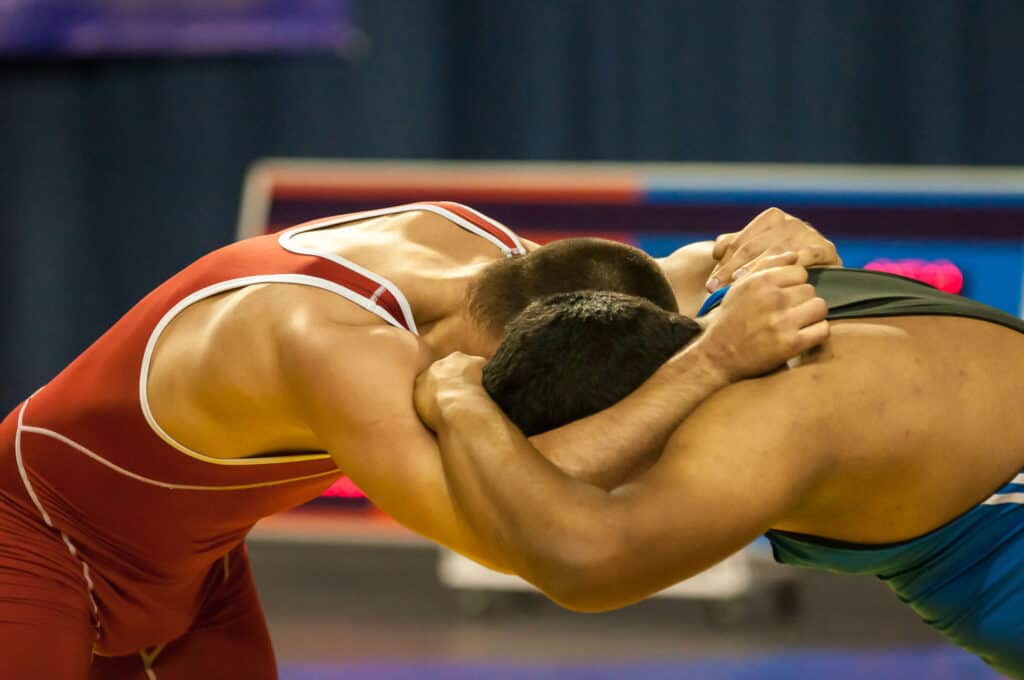
You’ve probably noticed that some of your favorite wrestlers have unusually thick necks. They’re powerful, seemingly unshakable, and as sturdy as ever, which leads one to believe there might be a correlation between thick necks and overall strength. Whether you’re watching Olympic-style or folkstyle wrestling, there are a couple of reasons wrestlers have thick necks.
Wrestlers have thick necks because strong and muscular necks come in handy during bridging when their back is stuck or when they’re finishing takedowns. They are also very crucial in preventing injuries. It relieves them the stress of having to deal with neck pains during the season.
This article will take you through why wrestlers have thick necks and the exercises you could do to increase your neck strength.
Why Wrestlers Have Thick Necks
A common characteristic among many wrestlers is their huge and thick necks, which seem to properly accentuate their huge and masculine body. A common misconception is that they were born with huge necks, just like most basketballers are born tall.
Well, this is true among some wrestlers. They can thank their good genes for their necks; however, many of them spend lots of time and effort on shaping their necks. Having a muscular neck has multiple advantages for a wrestler:
- Bridging when the back is stuck
- Finishing takedowns
- Reducing neck stress
- Reducing injuries
- Relieving neck pains
Overall, a strong neck lets a wrestler endure a long season and avoid injuries.
How To Get a Strong Neck for Wrestling
Which workouts will ensure you get a neck like your favorite wrestler’s? There are plenty of great exercises that you can use to strengthen your neck. If you have the funds I might suggest checking out the Iron Neck Exercise Machine. ( Affiliate Link )
The Iron Neck exercise machine provides you with everything you need to full neck workout. It is especially great for wrestlers and grapplers and is used by many elite athletes in the sport.
That said if Iron Neck is not an option for you now, then there are plenty of other exercises that can be done at the local gym or at home.
Neck Curl
The neck curl is simple to do. It is the foundation of any neck workout.
Neck curls engage the sternocleidomastoid muscle responsible for giving a thicker neck when you’re seen from the front. The whole routine involves stretching and contracting the muscles along the front part of the neck. The important thing to do is to ensure you feel the neck’s muscles curl up the weight.
I recommend incorporating rubber bump plates into your neck curl workout, although you can use your hands to push against your head. The Olympic Bumper Plate 2” – 5 Weight, a shock-absorbing and minimal bounce plate, is the perfect rubber bump plate based on my experience with several plates.
Remember to wear a protective cap or hat if you’re using hard metal plates to avoid bruising your head while working out.
Watch the YouTube video below to see how to do neck curls:
Neck Extension
Neck extensions help train the upper traps that run along the back of the neck and spinal erectors. It is simply like doing neck curls but in reverse.
Put a plate on the back of your head and extend it to the back. If you want to take your training a notch higher, consider investing in a Neck Weight Lifting Harness, which offers adjustable straps for neck workouts.
However, a neck harness is entirely optional, especially if your only goal is to achieve a muscular neck. It gives your upper back support by allowing you to plant your hands on the neck. The training may be a bit strenuous but satisfying, and you will be shocked by how much weight your neck can handle.
Neck Side Raises
To do this, lie on a bench and flex your neck in a sideways manner. You can use your hands to offer resistance or any other equipment that you have. My personal preference is weight plates simply because I can increase the load weight gradually, and it allows me to track my progress accurately. I recommend the BalanceFrom Cast Iron Olympic Weight Plates made with a solid iron cust that makes them durable.
Farmer’s Walks
Many athletes assume that farmer’s walks are only an off-grip strength exercise. This is contrary to the truth because they build quite a few muscles, including neck muscles and the traps. For this yoke-building exercise, you can use kettlebells, plates, or a set of dumbells.
Neck Bridges
Probably the most common neck exercise for wrestlers is the neck bridge. Of course, it does get some bad wrap for not being very safe. So if you are going to do neck bridges work your way up slowly and make sure you know what you are doing.
How Safe Are Wrestling Neck Workouts?
Neck training is generally safe as long as you do the right exercises with the right technique. Training the neck involves flexing and extending the cervical spine, which is equivalent to flexing and extending the lumbar spine during deadlifting.
However, neck training is way lighter than deadlifting. It is somehow the same as doing crunches, so you can repeat most neck exercises multiple times without experiencing severe side effects.
To be on the safe side, you should reduce the range of motion when working out the neck because the neck cannot move a lot like other joints such as the knee.
Conclusion
If you want a large neck size, ask a professional gym instructor or weight trainer to guide you. You could also watch YouTube videos of the workouts above, but be extra careful to avoid any injuries.
The advantages of having a thick neck are many, but if you’re not careful when using the equipment, it could be your worst nightmare.
